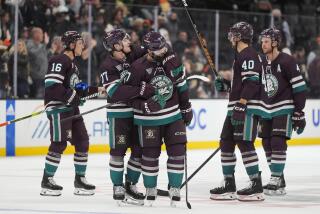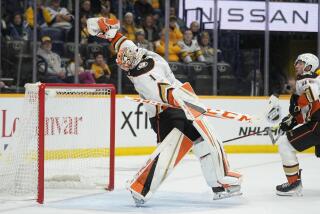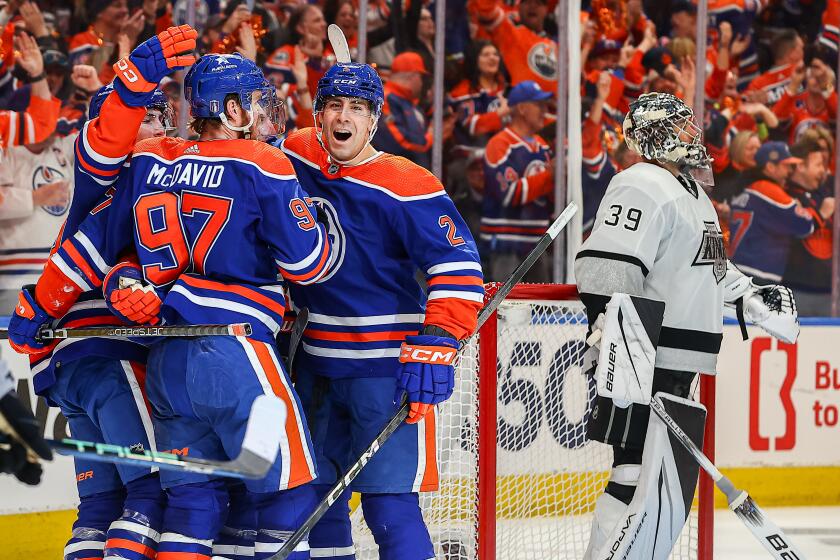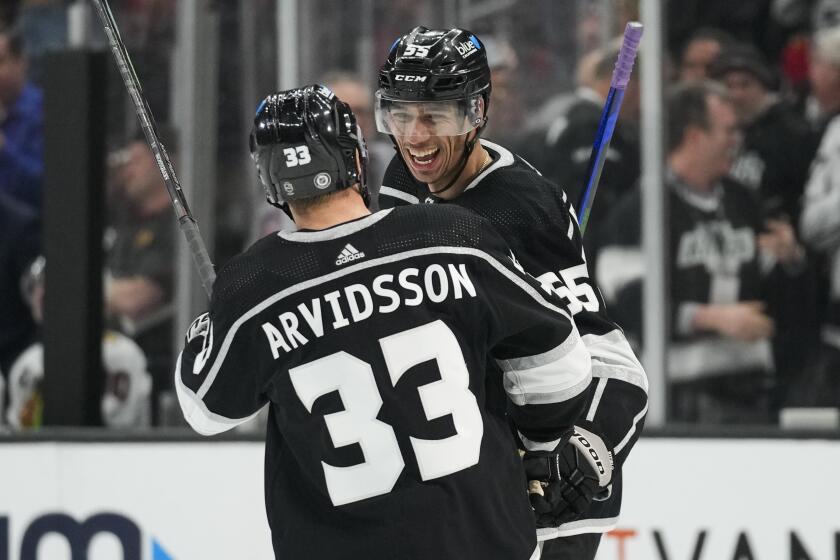Column: Injury to Corey Perry creates an opportunity for Ducks’ younger players to shine
Cruel business, this, but one player’s injury can become another player’s opportunity to launch a career. The Ducks, who had been following the rest of the NHL in looking to youthful legs to propel them, have now been forced by injuries to accelerate this reverse-aging process.
The rapid transition will carry some risks, but it also brings immense promise.
The Ducks announced Corey Perry had undergone surgery to repair the medial collateral ligament and meniscus of his right knee Wednesday with an expected recovery period of approximately five months. The 33-year-old right wing was injured during the warmups Monday before the team’s exhibition game against Arizona. General manager Bob Murray said Perry’s knee “just popped,” and that Perry had experienced problems before. “He usually needs about 10-15 minutes to walk away from something but he wasn’t walking away from this,” Murray said through a club spokesman.
Perry’s production had declined the past few seasons from his peak in 2010-11, when he led the NHL with 50 goals and was voted the league’s most valuable player, and he often was more than a step behind the play last season while scoring 17 goals in 74 games. His experience and ability to get on opponents’ nerves still had value. That same savvy and annoyance factor were the prime assets last season for center Ryan Kesler, 34, who played on a painful arthritic hip and scored only eight goals in 44 games.
Between Perry, Kesler — who hasn’t set a timetable for his season debut — and 34-year-old right wing Patrick Eaves, who is recovering from shoulder surgery and is likely to miss the first 10 games, the Ducks will have $18.825 million in salary not on the ice to start the season. And yet….
“Maybe there’s a silver lining,” Murray said of losing Perry. “Perhaps we should have fixed his injured knee before now. He’s a competitor and he tried to play through it.”
The Ducks also will have the consolation of seeing young players try to grow into roles they might not have been given if Perry, Kesler, and Eaves were ready to start the season and if restricted free agent winger Nick Ritchie were under contract. The Ducks’ 7-4 exhibition victory over the Kings on Wednesday at Anaheim showcased several forwards who appear poised to play important minutes and bring productive energy to a team that will be sternly tested to make the playoffs in the West.
Max Comtois, a 19-year-old who was chosen by the Ducks in the second round and 50th overall in the 2017 draft, was impressive in racking up an assist and scoring two goals — for a total of three in four games — at left wing with 2018 first-round pick Isac Lundestrom and veteran winger Brian Gibbons. Lundestrom is likely to go home to Sweden to gain muscle and experience, but Comtois appears to be a keeper. So does 20-year-old center Sam Steel, a first-round pick in 2016.
“My main goal coming in was to make the team, so every night I get the chance to put on the skates and go out there and do my job I just try and give my 100% and try to make a push to stay here,” said Comtois, whose sturdy 6-foot-2, 205-pound build will help his chances.
Troy Terry, a fifth-round pick in 2015 who played three seasons at the University of Denver and represented the U.S. at the Pyeongchang Olympics, has held a prime spot on the right side with Rickard Rakell and Ryan Getzlaf. Kiefer Sherwood, the recipient of rare praise from coach Randy Carlyle, undoubtedly won points when he got into a tussle Wednesday night with Kings forward Drake Rymsha. “Our youth has had success on the offensive side at lower levels and hopefully they can transition and continue to grow their game at the NHL level and continue to provide offense, and that’s really what we’re most encouraged by,” Carlyle said. “These players are stepping in and showing us they were worthy of where they were selected.”
It also works in the kids’ favor that Carlyle has said he intends to use four lines and give them balanced playing time. If he stays true to his plan, that means the kids won’t be limited to occasional duty. “We’re missing four or five guys that were on our hockey club and are NHL players. That’s got to be a feel-good story for the kids that are here, trying and vying for position,” Carlyle said.
Does he feel good about them? “Coaches never feel good. They’re always worried about what’s going to come, what’s going to happen tomorrow because our life changes from win to win, period to period, shift to shift,” he said.
Success from some of those talented kids could make him feel a lot better.
Follow Helene Elliott on Twitter @helenenothelen
More to Read
Go beyond the scoreboard
Get the latest on L.A.'s teams in the daily Sports Report newsletter.
You may occasionally receive promotional content from the Los Angeles Times.






